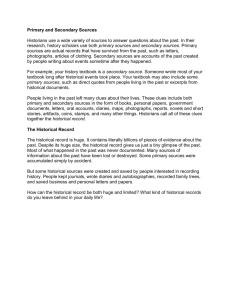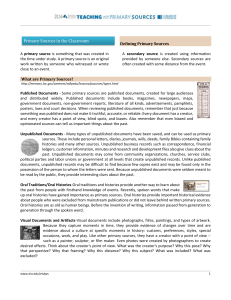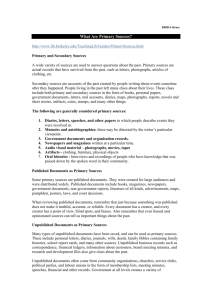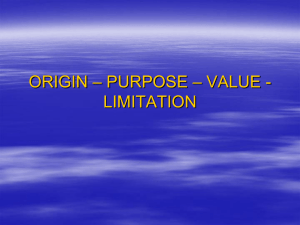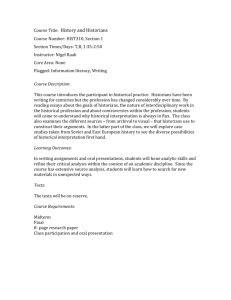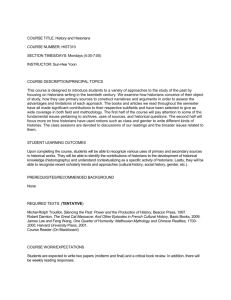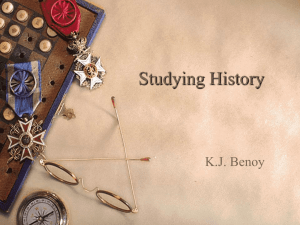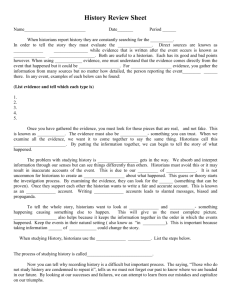Primary Source Activity - Darke County Education Service Center
advertisement
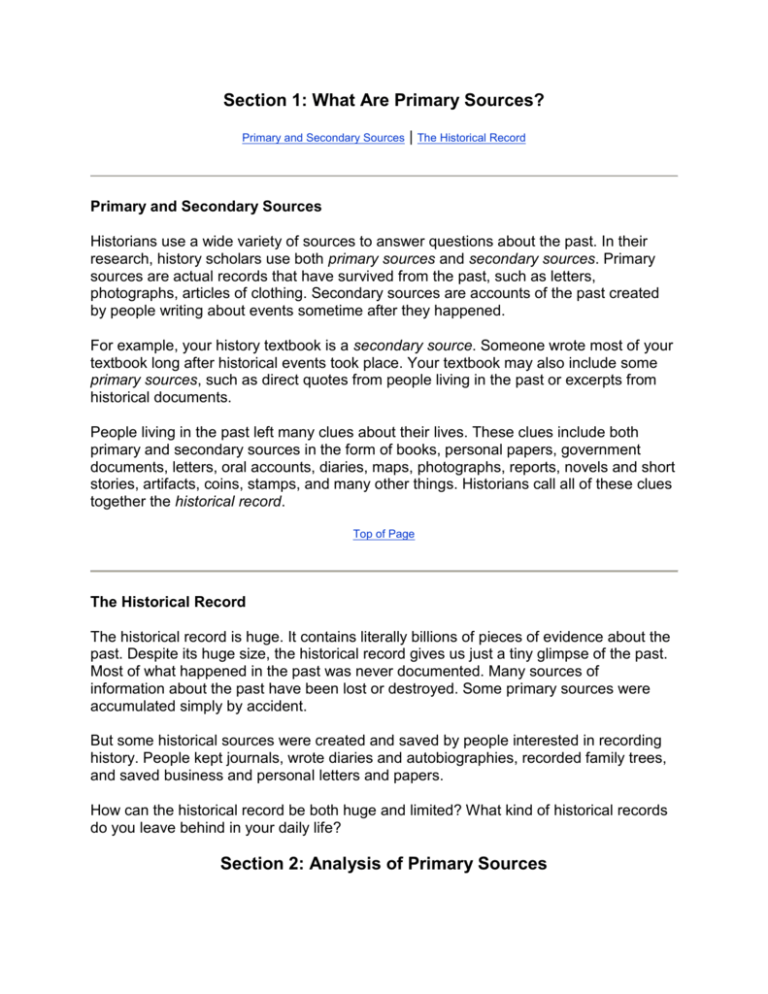
Section 1: What Are Primary Sources?
Primary and Secondary Sources
| The Historical Record
Primary and Secondary Sources
Historians use a wide variety of sources to answer questions about the past. In their
research, history scholars use both primary sources and secondary sources. Primary
sources are actual records that have survived from the past, such as letters,
photographs, articles of clothing. Secondary sources are accounts of the past created
by people writing about events sometime after they happened.
For example, your history textbook is a secondary source. Someone wrote most of your
textbook long after historical events took place. Your textbook may also include some
primary sources, such as direct quotes from people living in the past or excerpts from
historical documents.
People living in the past left many clues about their lives. These clues include both
primary and secondary sources in the form of books, personal papers, government
documents, letters, oral accounts, diaries, maps, photographs, reports, novels and short
stories, artifacts, coins, stamps, and many other things. Historians call all of these clues
together the historical record.
Top of Page
The Historical Record
The historical record is huge. It contains literally billions of pieces of evidence about the
past. Despite its huge size, the historical record gives us just a tiny glimpse of the past.
Most of what happened in the past was never documented. Many sources of
information about the past have been lost or destroyed. Some primary sources were
accumulated simply by accident.
But some historical sources were created and saved by people interested in recording
history. People kept journals, wrote diaries and autobiographies, recorded family trees,
and saved business and personal letters and papers.
How can the historical record be both huge and limited? What kind of historical records
do you leave behind in your daily life?
Section 2: Analysis of Primary Sources
Time and Place Rule
| Bias Rule | Questions for Analyzing Primary Sources
Historians analyze historical sources in different ways. First, historians think about
where, when and why a document was created. They consider whether a source was
created close in location and time to an actual historical event. Historians also think
about the purpose of a source. Was it a personal diary intended to be kept private? Was
the document prepared for the public?
Some primary sources may be judged more reliable than others, but every source is
biased in some way. As a result, historians read sources skeptically and critically. They
also cross-check sources against other evidence and sources. Historians follow a few
basic rules to help them analyze primary sources. Read these rules below. Then read
the questions for analyzing primary sources. Use these rules and questions as you
analyze primary source documents yourself.
Time and Place Rule
To judge the quality of a primary source, historians use the time and place rule. This
rule says the closer in time and place a source and its creator were to an event in the
past, the better the source will be. Based on the time and place rule, better primary
sources (starting with the most reliable) might include:
Direct traces of the event;
Accounts of the event, created at the time it occurred, by firsthand observers and
participants;
Accounts of the event, created after the event occurred, by firsthand observers
and participants;
Accounts of the event, created after the event occurred, by people who did not
participate or witness the event, but who used interviews or evidence from the
time of the event.
Top of Page
Bias Rule
The historians' second rule is the bias rule. It says that every source is biased in some
way. Documents tell us only what the creator of the document thought happened, or
perhaps only what the creator wants us to think happened. As a result, historians follow
these bias rule guidelines when they review evidence from the past:
Every piece of evidence and every source must be read or viewed skeptically
and critically.
No piece of evidence should be taken at face value. The creator's point of view
must be considered.
Each piece of evidence and source must be cross-checked and compared with
related sources and pieces of evidence.
Top of Page
Questions for Analyzing Primary Sources
The following questions may help you judge the quality of primary sources:
1. Who created the source and why? Was it created through a spur-of-the-moment
act, a routine transaction, or a thoughtful, deliberate process?
2. Did the recorder have firsthand knowledge of the event? Or, did the recorder
report what others saw and heard?
3. Was the recorder a neutral party, or did the creator have opinions or interests
that might have influenced what was recorded?
4. Did the recorder produce the source for personal use, for one or more
individuals, or for a large audience?
5. Was the source meant to be public or private?
6. Did the recorder wish to inform or persuade others? (Check the words in the
source. The words may tell you whether the recorder was trying to be objective
or persuasive.) Did the recorder have reasons to be honest or dishonest?
7. Was the information recorded during the event, immediately after the event, or
after some lapse of time? How large a lapse of time?
8. Section 3: Types of Primary Sources
9. Published Documents | Unpublished Documents | Oral Traditions/Histories | Visual Documents/Artifacts
10.
11. When analyzing primary sources, historians consider the type of primary source
under study. Different primary sources were created for different reasons.
Knowing the different types of primary sources will help you evaluate the
reliability of primary sources. Read about the different types of primary sources
below.
12. Published Documents
Some primary sources are published documents. They were
created for large audiences and were distributed widely.
Published documents include books, magazines, newspapers,
government documents, non-government reports, literature of all
kinds, advertisements, maps, pamphlets, posters, laws, and
court decisions.
[The past is behind us.]
Gerrit Albertus Beneker (b.
1882). Poster, 1918.
The Presidential Election of
1920: Introduction
When reviewing published documents, remember that just
because something was published does not make it truthful,
accurate, or reliable. Every document has a creator, and every
creator has a point of view, blind spots, and biases. Also
remember that even biased and opinionated sources can tell us
important things about the past.
Unpublished Documents
[Letter from Mathew Brady to President
Abraham Lincoln, asking Lincoln to sit
for a photograph], 1865 March 2
Many types of unpublished documents have been saved,
and can be used as primary sources. These include
personal letters, diaries, journals, wills, deeds, family
Bibles containing family histories, school report cards,
and many other sources. Unpublished business records
such as correspondence, financial ledgers, information
about customers, board meeting minutes, and research
and development files also give clues about the past.
Unpublished documents often come from community
organizations, churches, service clubs, political parties,
and labor unions in the form of membership lists,
meeting minutes, speeches, financial and other records.
Government at all levels creates a variety of unpublished
records. These include police and court records, census
records, tax and voter lists, departmental reports, and
classified documents.
13. Unlike published documents, unpublished records may be difficult to find
because few copies exist. For example, personal letters may be found only in the
possession of the person to whom the letters were sent. Letters of famous or
remarkable people may be collected and eventually published. Keep in mind that
letter writers did not intend (and perhaps could not imagine) that their letters
would be read by more than one person. Because unpublished documents were
seldom meant to be read by the public, they provide interesting clues about the
past.
14. Oral Traditions/Oral Histories
Delacroix Island, St Bernard Parish,
Louisiana. January 1941. A Spanish
muskrat trapper in the doorway of his
marsh home.
Oral traditions and oral histories provide another way to
learn about the past from people with firsthand knowledge
of historical events. Recently, spoken words that make up
oral histories have gained importance as primary sources.
Historians and others find out about the lives of ordinary
people through spoken stories and tales. Oral histories
provide important historical evidence about people,
especially minority groups, who were excluded from
mainstream publications or did not leave behind written
primary sources.
Oral histories are as old as human beings. Before the
invention of writing, information passed from generation to
generation through the spoken word. Many people around
the world continue to use oral traditions to pass along
knowledge and wisdom. Interviews and recordings of
community elders and witnesses to historical events
provide exciting stories, anecdotes, and other information
about the past.
15. Visual Documents and Artifacts
Visual documents include photographs, films, paintings, and other
types of artwork. Because visual documents capture moments in
time, they can provide evidence of changes over time. Visual
documents include evidence about a culture at specific moments
in history: its customs, preferences, styles, special occasions,
work, and play.
Mulberry Street,
New York City
[1900]
Like other primary source documents, a visual document has a
creator with a point of view -- such as a painter, sculptor, or film
maker. Even photographs were created by photographers using
film and cameras to create desired effects.
16. Think about the creator's point of view when you review visual documents. What
was the creator's purpose? Why this pose? Why that perspective? Why that
framing? Why this distance? Why this subject? What was included? What was
excluded? Using visual documents as primary sources requires careful analysis
of the content and the point of view of the creator.
Auction and Negro Sales, Whitehall Street,
Atlanta, Georgia (1864)
American Life Histories, 1936-1940
[Mrs. Lula Bowers, II]
{Begin handwritten} Beliefs Customs - Customs {End handwritten}
Accession no. - 10160
Date received - 10/10/40
Consignment no.
Shipped from Wash. Off.
Label
Amount - 4p.
WPA L. C. PROJECT Writers' UNIT
Form[md]3
Folklore Collection (or Type)
Title Social Customs. Mrs. Lula Bowers II
Place of origin Hampton Co., S. Car. Date 6-28-38
Project worker Phoebe Faucette
Project editor
Remarks
{Begin deleted text} 8882 {End deleted text}
Project #-1655
Phoebe Faucette
Hampton County {Begin handwritten} [?] {End handwritten} {Begin deleted text} 390552
{End deleted text}
Records of the Past
SOCIAL CUSTOMS
Mrs. Lula Bowers {Begin handwritten}, II {End handwritten}
...."There is a great change in the men and women, too, from what it used to be. It used
to be that the men tended to all the business. Now most all the business is tended to by
the women!
I remember the first woman free dealer. She was Mr. Ned Morrison's grandmother. She
was the first free-dealer I ever heard of. Her husband was an excellent man but no
business man. He had a large farm to manage after the war, with free labor. He'd get so
mad with the negroes that he'd just let them go, and give up. So she had to take charge.
She went to the courthouse and got an appointment. She was the only woman I know
that got an appointment to run her own farm. Now women run their farms if they want to.
"The churches and schools wasn't much. They got free-schools for three months then.
Now they get it for nine.
"The roads weren't good either like they are now. And it was so hard to get anybody to
work on the roads. Each farmer had to send a certain amount of hands to work the
roads, and someone had to oversee the work. My father was generally the one.
"In slavery time we had three slave quarters - ten houses in each quarter. The houses
were kept nice, kept clean. And there was one special house where they kept the
children and a nurse. The houses were log-houses, and they didn't have any windows
more than ten or twelve inches square. And they had shutters, not sash. The hinges for
the shutters were made in the blacksmith shop. They wouldn't have but two rooms. Very
often they wouldn't have lumber enough to put in the partition, and would have to hang
up sheets between the rooms.
They'd ceil them with clapboards from the woods. Their furniture was just anything that
they could get - little stools, and little benches, and just anything. They'd use the back of
their old dresses for quilts.
"The clothes of the slaves were spun at home and made by their mistresses. The'd
weave them white, then dye the cloth. They'd go in the woods and get bark and dye
them.
"The slaves had bread and hominy, and what little meat they could get hold of now and
then. There were a lot of cattle in this country. And they raised a lot of geese, and
guineas, and such like. Most of the slaves were doctored by their owners. Dr. Nathan A.
Johnston was the first doctor I knew anything about. They'd rake soot off the back of the
chimney and make a tea out of it for the colic. Called it soot-tea. I've seen my
grandmother do it a many a time! The slaves didn't have any education in that day.
They'd have Sunday Schools for the white people and for the slaves. The old people
would write down what the children had to say. They had no books then, and paper was
so scarce they sometimes had to use paste-board. When the slaves wanted to go off on
a visit they were given tickets, and allowed to go for just so many hours.
"After the war, military rule was oppressive for a while; but they got so they dropped
that. There was much lawlessness. There was no law at all, and they couldn't manage
the negroes at all. There was a man that came from Beaufort named Wright, and he
controlled them. He was a northerner but he was a
good man. He and his wife came. They stayed in three different homes when they were
here. Only three homes would take those people in! One of them was a relative of mine.
She said one night Mrs. Wright said she would make a pudding for them all - what she
called Hasty Pudding. So my aunt got out the sugar, and eggs and seasonings for her;
but the 'Pudding' proved to be just Fried Hominy - cold hominy sliced and rolled in egg
and flour and fried. They had a son and a daughter. After a while they came, too,"
Source: Mrs. Lula Bowers, 79, Luray, S. C.
